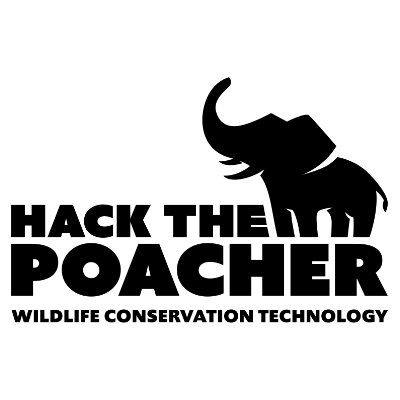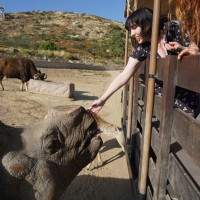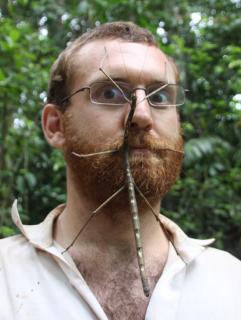Sensors already equip a range of tools to enhance monitoring capacity for conservation. Some of the higher bandwidth technologies, like camera traps and acoustic monitoring systems, have been essential elements of the conservation toolkit for decades, and thus have enough users that we've created dedicated WILDLABS groups to address them. But a whole range of lower bandwidth sensors beyond these core technologies are being increasingly integrated into conservation monitoring systems, and offer rich new insights into the wildlife and ecosystems we're all working to protect. As with many technologies, cost and access have historically been challenges to the adoption of new sensors, but with low-cost and open-source solutions on the rise, we're excited to see what the future of this space holds.
Getting Started with Sensors:
- Watch Shah Selbe's Tech Tutors episode on scaling FieldKit, an open-source conservation sensor toolbox, from a project to a successful conservation tech product.
- Check out our Virtual Meetup about Low-Cost, Open-Source Solutions in conservation tech, including a talk by Alasdair Davies on the Arribada Initiative's work with thermal sensors in early warning systems.
- For a more in-depth introduction, watch the first video in our datalogger mini-series: Freaklabs: How do I get started with Arduino?
In this group, you'll meet others who are using and innovating diverse sensors in their work, discuss ways to make sensors more effective & accessible for conservationists, learn about what sensors are already helping us accomplish in the field, and have the opportunity to ask and answer questions. Join this group to get started!
Header image: Emma Vogel, University of Tromsø
WILDLABS
This account is managed by the WILDLABS Team. Tag us or DM whenever you need help from our community team.



- 22 Resources
- 23 Discussions
- 11 Groups
- @MichaelMaggs
- | he/him
Frontier Labs
Bioacoustics lover and director @ Frontier Labs
- 0 Resources
- 3 Discussions
- 3 Groups
- @apcxs
- | He, his, them
- 0 Resources
- 0 Discussions
- 11 Groups
Director of Icoteq Ltd, an electronics and software design consultancy developing wireless products and solutions to organisations working in the conservation, wildlife monitoring and anti-poaching sectors. Developers of the TagRanger® novel wildlife tracking products.



- 1 Resources
- 14 Discussions
- 7 Groups
- 0 Resources
- 3 Discussions
- 8 Groups
- @nabilla.nuril
- | She/Her
University College London (UCL)
- 0 Resources
- 0 Discussions
- 11 Groups
Wildlife researcher

- 1 Resources
- 12 Discussions
- 5 Groups
- 0 Resources
- 6 Discussions
- 3 Groups
- @IvanIoSA
- | He/Him
CTO of IoSA, the Internet of Small Animals. Creator of ProxLogs

- 0 Resources
- 5 Discussions
- 7 Groups
- @mahmudku
- | he/him/his
Mahmud Rahman is an MS student at Oregon State University, studying the risk-taking behavior of bottlenose dolphins. With experience in wildlife filmmaking, he aims to develop technologies to advance marine research
- 0 Resources
- 0 Discussions
- 3 Groups
St. Lawrence University
Professor of Biology at St. Lawrence University
- 0 Resources
- 2 Discussions
- 13 Groups
Max Planck Institute of Animal Behavior
- 0 Resources
- 2 Discussions
- 5 Groups
PhD position available at the University of Konstanz in the Active Sensing Collective Group!
28 March 2025
We are hiring for a customer support / marketing specialist.
20 February 2025
Osa Conservation is launching our inaugural cohort of the ‘Susan Wojcicki Research Fellowship’ for 2025, worth up to $15,000 per awardee (award value dependent on project length and number of awards given each year)....
10 February 2025
New paper - "acoupi integrates audio recording, AI-based data processing, data management, and real-time wireless messaging into a unified and configurable framework. We demonstrate the flexibility of acoupi by...
7 February 2025
The Conservation Technology Laboratory within the Population Sustainability department is seeking two fellows for summer 2025
5 February 2025
Conservationists use tools like drones, satellites, and camera traps to monitor ecosystems and scale their impact. But new challenges like transparency, funding gaps, and engagement remain. Web 3.0 technologies offer...
28 January 2025
The worst thing a new conservation technology can do is become another maintenance burden on already stretched field teams. This meant Instant Detect 2.0 had to work perfectly from day 1. In this update, Sam Seccombe...
28 January 2025
The Zoological Society of London's Instant Detect 2.0 is the world's first affordable satellite connected camera trap system designed by conservationists, for conservationists. In this update, Sam Seccombe describes the...
21 January 2025
Over the years, a large number of developments have gone up in the area that I live in and the municipality is not doing what they should when it comes to upholding the laws that have been put in place to protect the...
20 January 2025
The Marine Innovation Lab for Leading-edge Oceanography develops hardware and software to expand the ocean observing network and for the sustainable management of natural resources. For Fall 2025, we are actively...
6 October 2024
Join the team at FieldKit, an open-source software and hardware sensor platform, and help us validate the quality and usability of the FieldKit platform.
25 September 2024
July 2024
April 2024
event
16 Products
Recently updated products
117 Products
1 R&D Projects
81 Organisations
Recently updated products
Recently updated R&D Projects
Recently updated organisations
| Description | Activity | Replies | Groups | Updated |
|---|---|---|---|---|
| Would certainly be cool to see a tutorial on this! Looking forward to that! |
|
Marine Conservation, Sensors | 3 years 8 months ago | |
| Almost done with the trap alarms. I added an additional buzzer (with internal circuitry) to get more noise. The added benefit is that the slightly different tunes creates... |
|
Sensors | 4 years ago | |
| Hi Barry, I am tinkering with similar edge devices and aspirations! I recently acquired the Jetson Nano to start testing some aspects of the BearID Project software pipeline.... |
|
Connectivity, Sensors | 4 years 2 months ago | |
| Thanks for the paper Harold, this looks like a possibility. Especially if there's a way to make bespoke detectors |
+22
|
Sensors | 4 years 2 months ago | |
| Hi everyone, I'm building some small audio attachments to pop onto Vectronics collars. Does anyone have dummy or... |
|
Sensors | 4 years 2 months ago | |
| Really interesting chat. I was looking at this "eTape" to measure inundation on marine turtle nests. https://www.adafruit.com/product/463 Will give you water presence... |
+10
|
Sensors | 4 years 6 months ago | |
| Have you ever wanted to get a sample from the top of a tree, without having to climb it or shoot it out with a shotgun? Would it... |
|
Sensors | 4 years 6 months ago | |
| Hello Rob, I have seen the bracelet style used on large mammals with mixed success and failure. The main considerations are terrain the animal uses, and fitting the bracelet... |
|
Sensors | 4 years 6 months ago | |
| Amazing stuff Andrew! The dips in light idea made me think of exoplanet hunting straight away! Such a cool idea!! |
|
Sensors | 4 years 7 months ago | |
| Hi Akiba No worries, thanks for responding! I'd love to delve into more detail on this once the new series has started and I have an idea of the tools and kit required!... |
|
Open Source Solutions, Sensors | 4 years 8 months ago | |
| Hi Maxine, There are pros and cons to switching regulators and linear regulators. Linear regulators "throw away" the excess voltage in order to maintain a... |
|
Open Source Solutions, Sensors | 4 years 8 months ago | |
| Hi. I've been following the opencollar initiative and was wondering what the current status is. The project looks amazing! |
|
Sensors | 4 years 9 months ago |
Webinar: The Next Generation Of Animal Telemetry
 BOEM
BOEM
1 June 2020 12:00am
Competition: 2020 Hackaday Prize
26 May 2020 12:00am
Grassroots Innovations for Wildlife Conservation
19 May 2020 12:00am
WILDLABS Tech Tutors: Season One
19 May 2020 12:00am
12th International Forum on Illegal, Unreported and Unregulated Fishing
 Chatham House
Chatham House
14 May 2020 12:00am
sound loop devise
26 April 2020 1:29pm
12 May 2020 7:14pm
Hi Eric, I think you could do away with an inverter, and instead use something like a DC-DC step-down (sometimes called a 'buck') converter. The solar and battery system is 12VDC correct? Chances are that the MP3 player wall charger is pumping out something like 5VDC (it should be written on the side of the plug)? Something like this would work: https://www.altronics.com.au/p/z6338-dc-dc-converter-module-3.5-35v-input-5-56v-output/
or if it is a 12V battery as I suspect, virtually any 'car' charger for a phone would do (just as I suspect the powerbank will). Hopefully, a large capacity powerbank is enough anyway, and you don't even need solar...
13 May 2020 12:39pm
Yes im hoping the power bank and a few extra mp3s will get it done this year. will look into a better system this winter now that I have some help:)
Era of the Condor: A Species' Future in Recovery
5 May 2020 12:00am
Notification systems for trap activation
10 January 2019 5:30am
4 May 2020 2:05am
Hi Rahid,
Thanks for your reply. In answer to your questions:
#1
There would be no external power (or cell phone reception) available at any of the node? The nodes would need to be completely autonomous.
#2
Total number of nodes would likley be in the range of 100–200 within a project area.
#3
The maximum distance between two nodes would likely be 5 km.
#4
All i want to transmit is an alert to say whether a trap has been activated or not. No video is required.
Many thanks,
Andrew
4 May 2020 3:00am
Ok, we can customize a solution for you, but probably won't be able to get this out to you for around 3-4 months.
RF and mesh is our domain. We can guarantee NLOS at well over 20 km+.
5KM in not a large distance. Not sure if LoRa can handle 200 nodes or work in the bush --- trees are the enemy of anything above 300 MHz.
I'm all for using HF (below 30MHz) or tactical VHF (30-108 MHz).
Would 1-1.6m antennas work?
---
I can email you a case study for a much more complex project that we did last December .
We were able to transmit video using 100KHz of bandwidth over a frequency of 30.5 MHz. Our moving car was traveling at 130 km/h and achieved a 64km+ distance from the base station --- we used 50% less bandwidth to transmit video than what an FM radio station uses to transmit tunes and other meta data. Our glass to glass (camera lense to monitor) latency was 24ms.
---
Our solutions don't require an expensive sattelite link or any phone network to work (although we can add those options).
What this means is that our radios will always work, come rain, come snow, et al. --- Satellite links are easily disrupted by a low cast / clouds , etc.
Our signals reflect and refract of the ground and the ionosphere to give you NLOS in any condition.
So a sensor based project of 200 nodes is no problem at all.
---
If waiting 3-4 months is not a big deal, then we can donate a few units to your project once we learn more about it.
---
4 May 2020 5:01am
Please see my edits above
Competition: iWildCam 2020
4 May 2020 12:00am
Mesh Powered Software Defined Radios
2 May 2020 7:13am
Call for Submissions – Arm Research Summit 2020
24 April 2020 12:00am
Talking Tracking with Xerius
23 April 2020 12:00am
#FieldKit50: Earth Day Giveaway
22 April 2020 12:00am
WILDLABS Tech Hub: WWF PandaSat
13 April 2020 12:00am
Locally-Brewed Conservation Technology from a Small Town in North Bengal
10 April 2020 12:00am
Connecting to MBARI's Deep-Sea Instruments
31 March 2020 12:00am
WILDLABS Community Call Recording: Rainforest X-PRIZE
30 March 2020 12:00am
Virtual Field Trip: Conservation Technology with Shah Selbe
24 March 2020 12:00am
Online Workshop: Conservation Technology
 Hack the Poacher
Hack the Poacher
23 March 2020 12:00am
Enter the Zooniverse: Try Citizen Science for Yourself!
18 March 2020 12:00am
Webinar: IIED Community-Based Approaches to Tackling Poaching and Illegal Wildlife Trade
 IIED
IIED
17 March 2020 12:00am
Tutorial: Train a TinyML Model That Can Recognize Sounds Using Only 23 kB of RAM
16 March 2020 12:00am
Testing an Early Warning System to Mitigate Human-Wildlife Conflict on the Bhutan-India Border
11 March 2020 12:00am
Proximity Data - Analysis methods
10 March 2020 2:44pm
3 Ways Your Conservation Technology Could Become a Shiny Pile of Junk, and How to Avoid It
9 March 2020 12:00am
#Tech4Wildlife 2020 Photo Challenge In Review
4 March 2020 12:00am
sound loop device
3 March 2020 1:59am
Call for Nominations: Tusk Conservation Awards
3 March 2020 12:00am
Competition: Plastic Data Challenge
 Ellie Warren
Ellie Warren
3 March 2020 12:00am
Hawai'i Conservation Conference
 Hawaiʻi Conservation Alliance
Hawaiʻi Conservation Alliance
28 February 2020 12:00am






























































12 May 2020 4:07pm
I reckon if you could get down to a power consumption of 2-3Ah per day like our system had then a battery of 20Ah is suitable for a week and you wouldn't need inverters and solar panels etc. I agree that in your environment everything will struggle with being powered for 24hrs. I rarely have that problem to contend with! Will have a look at a temperature test of our design over the Summer and will share the details in a blog if it looks like it will prove a solution for all environments.